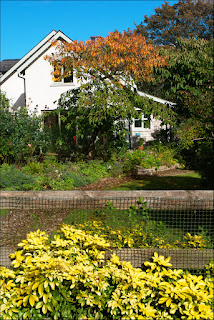It its thirteen and a half years ago we moved into our new built house, up a lane from the town, up a cul-de-sac, up a field. We planted shrubs and trees, planted out beds and now it is all growing too well, too large. So decisions need to be taken, what to prune, what to remove.
 The trouble with plants is that they grow and breed and not wanting to throw them away there are clumps of anemones and acanthus in the long grass, aquilegias and forgetmenots sowing themselves in the wood. So do we let areas go wild and do whatever they want to do, do we cull our flora (could do with culling the rabbits and grey squirrels) or let it rampage?
The trouble with plants is that they grow and breed and not wanting to throw them away there are clumps of anemones and acanthus in the long grass, aquilegias and forgetmenots sowing themselves in the wood. So do we let areas go wild and do whatever they want to do, do we cull our flora (could do with culling the rabbits and grey squirrels) or let it rampage?
 R wants to see the water in the pond, the reflection of the sky, the plants want to take over which is great for newts and other pond life. We have had the water lily dug out - well most of it - and I have raked mounds of plantain onto the bank.
R wants to see the water in the pond, the reflection of the sky, the plants want to take over which is great for newts and other pond life. We have had the water lily dug out - well most of it - and I have raked mounds of plantain onto the bank.
The garden is on a junction between two geological layers - this results in aquifers and springs erupting from the slopes. Water has an insidious way of appearing just where you do not want it. We drained parts of the garden but the drains are blocked - probably roots from trees - this results in boggy areas (where mowers get bogged down) and squelchy lawn.
The veg beds strategically placed to get the best of the sun are now partially overlooked and shaded by the big damson tree. (It was only small when we put it in.) They need to be moved. We have too many currant bushes - it is so tempting to cut a stem and stick it in the ground - voila!, a new bush.

 Autumn colours are here - the Acer sango-kaku - given to us by my sister I when we moved here. The sunlight on the golden leaves is spectacular. And up in the wood the Azaleas are also magnificent in their October plumage.
Autumn colours are here - the Acer sango-kaku - given to us by my sister I when we moved here. The sunlight on the golden leaves is spectacular. And up in the wood the Azaleas are also magnificent in their October plumage.
 Up in the woodland the small boy reading a book is well wrapped in Moss for the winter cold. With the increasing damp in the garden moss is thriving. The path from the house to the veg beds has a thick coating. This can make it slippery and an old crock like me has to be careful. I think I will have to buy some crampons to walk the muddy slopes and stop me ending up on my backside (again). In fact I am off to an osteopath this week though I am unsure that anything much will help but a body transplant. (Probably could do with a brain transplant too.) The lawns need tining - stick a fork in and waggle to open the turf and help drainage - not a job I love so beware S the gardener. It is almost time for the blower too, to clear the paths of fallen leaves - can do that.
Up in the woodland the small boy reading a book is well wrapped in Moss for the winter cold. With the increasing damp in the garden moss is thriving. The path from the house to the veg beds has a thick coating. This can make it slippery and an old crock like me has to be careful. I think I will have to buy some crampons to walk the muddy slopes and stop me ending up on my backside (again). In fact I am off to an osteopath this week though I am unsure that anything much will help but a body transplant. (Probably could do with a brain transplant too.) The lawns need tining - stick a fork in and waggle to open the turf and help drainage - not a job I love so beware S the gardener. It is almost time for the blower too, to clear the paths of fallen leaves - can do that.The leaves are falling from the toffee trees (cercidiphyllum) but I do not smell the caramel aroma they are supposed to have.









Your sango kaku is gorgeous. We planted one last year & sadly it developed Pseudomonas syringae and died. We were told by some people who grow many specimens of JM that we should not plant another JM in that same spot. Oh, well.
ReplyDelete